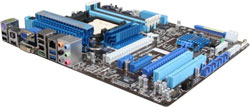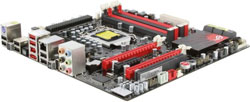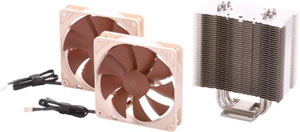Holiday 2010 System Builder's Guide
by AnandTech Staff, edited by Jarred Walton on November 19, 2010 2:00 AM EST- Posted in
- Guides
- Systems
- Holiday 2010
Raja's Midrange Overclocking Systems
What about building a bang-for-the-buck overclocking experience, you ask? As our resident overclocking guru and motherboard reviewer, Raja has more experience with this area than the rest of us so we turned this section over to him. In order to keep things simple, we kept nearly all of the components in Vivek's midrange build but switched out the motherboard, processor, RAM and PSU. We also added an aftermarket cooler to allow the CPUs to reach their full potential. Here's what Raja put together. [Ed: Text by Jarred, most of the picks by Raja.]
| Raja's Midrange AMD Overclocking System | ||
| Hardware | Component | Price |
| Processor |
AMD Phenom II X6 1055T (Thuban 45nm, 2.8 to 3.3 GHz, 6x512KB L2, 6MB L3, 125W |
$179 |
| Motherboard | ASUS M4A89GTD Pro (AMD 890GX AM3) | $135 |
| CPU Cooler | Noctua NH-U12P SE2 120mm SSO | $60 |
| Video | ASUS Radeon HD 6850 1GB (EAH6850) | $200 |
| Memory | G.Skill 2x2GB DDR3-1600 (F3-12800CL9D-4GBNQ) | $65 |
| Hard Drive | WD Caviar Blue 1TB (WD10EALS) | $70 |
| Optical Drive | ASUS 24x DVDRW (DRW-24B1ST) | $20 |
| Power Supply | Seasonic S12II 620W Bronze (80 Plus Bronze) | $75 |
| Case | Antec Nine Hundred Two | $89 |
| Total System Price | $893 | |
For AMD overclocking, I chose one of the hex-core Thuban CPUs, just so you can get every last ounce of performance out of AMD's architecture. The ASUS motherboard ended up being our top AM3 overclocking selection--at least when keeping prices in check--and is good for up to a 50% overclock by raising the base clock. Thuban will  generally top out in the 4.0-4.2GHz range, making this board a perfect fit. The Noctua cooler will help keep things cool without making a ton of noise, and the Seasonic S12II 620W power supply should deliver clean, stable current to the system.
generally top out in the 4.0-4.2GHz range, making this board a perfect fit. The Noctua cooler will help keep things cool without making a ton of noise, and the Seasonic S12II 620W power supply should deliver clean, stable current to the system.
Alternately, if you want to spin the wheel, you can also try your hand at core unlocking and save some money. $100 will buy you the Phenom II X2 560 Black Edition, which has two disabled cores. The ASUS board allows core unlocking, provided your CPU can handle it. Many users have had success with core unlocking, but there's no guarantee, and you'll never get the six cores that Thuban processors offer.
Our memory kit may not look like much, with its DDR3-1600 speed and CAS 9 timings. In reality, it shouldn't limit you but it's getting tricky to determine which memory to buy for overclocking. Vendors are now covering up their IC choices so much it's difficult to know what's inside; what we're looking for is an Elpida BBSE type variant or a similar IC from PSC. The G.Skill kit should work, but YMMV.
| Raja's Midrange Intel Overclocking System | ||
| Hardware | Component | Price |
| Processor |
Intel Core i5-760 Lynnfield 45nm (4x2.8GHz to 3.33GHz Turbo, 8MB L3, 95W) |
$200 |
| Motherboard | ASUS Maximus III GENE (Intel P55 1156) ($20 MIR) | $127 |
| CPU Cooler | Noctua NH-U12P SE2 120mm SSO | $60 |
| Video | ASUS Radeon HD 6850 1GB (EAH6850) | $200 |
| Memory | G.Skill 2x2GB DDR3-1600 (F3-12800CL9D-4GBNQ) | $65 |
| Hard Drive | WD Caviar Blue 1TB (WD10EALS) | $70 |
| Optical Drive | ASUS 24x DVDRW (DRW-24B1ST) | $20 |
| Power Supply | Seasonic S12II 620W Bronze (80 Plus Bronze) | $75 |
| Case | Antec Nine Hundred Two | $89 |
| Total System Price | $906 | |
Okay, first let's get this out of the way: Sandy Bridge is right around the corner. Think your hopped up i5-760 overclock is impressive? Imagine an unlocked Sandy Bridge chip running at 4.3-4.5GHz on air cooling. If you're into Intel overclocking, we'd really consider just waiting a bit longer right now. But, if you must buy a P55 system right now and you want a good overclock....
For the CPU, the i5-760 remains the most sensible choice. Priced at $200, you still get four cores with great overclocking potential--hitting 4.0-4.2GHz is generally common with an appropriate motherboard and cooling. The jump to i7-870 is $80 and all you really get is Hyper-Threading, since maximum  overclocking means you'll want to disable the Turbo Boost feature and most of the Lynnfield CPUs are going to top out around the same 4.2GHz. We might be swayed to make an investment in Core i7 if it weren't for Sandy Bridge; then again, there's an upside: motherboards that used to push nearly $200 have come down quite a bit and there are plenty of rebates going around right now.
overclocking means you'll want to disable the Turbo Boost feature and most of the Lynnfield CPUs are going to top out around the same 4.2GHz. We might be swayed to make an investment in Core i7 if it weren't for Sandy Bridge; then again, there's an upside: motherboards that used to push nearly $200 have come down quite a bit and there are plenty of rebates going around right now.
The motherboard is always a critical component for overclocking, and even though there are plenty of options that can do well, we wanted something more than just a decent overclock. The ASUS Maximus III GENE can easily hit BLCKs far beyond what you'll need for an i5-760, but even better is the excellent voltage regulation that will allow you to push 4GHz and higher without pumping a ton of current through your CPU. ASUS also makes overclocking very easy on the less experienced, with only minor tweaks necessary to get your system running at top speed.
Cooling for both systems comes courtesy of the Noctua NH-U12P SE2, a high quality push-pull cooler capable of keeping your CPU temperatures down without raising noise levels.  While there are decent coolers for a bit less money, we've never been disappointed by the Noctua; it works well even with hex-core processors if you move to X58, so the Lynnfield CPUs aren't going to be a problem.
While there are decent coolers for a bit less money, we've never been disappointed by the Noctua; it works well even with hex-core processors if you move to X58, so the Lynnfield CPUs aren't going to be a problem.
You'll notice that the power supply isn't the OCZ model Vivek used; instead the PSU is a higher quality Seasonic S12II capable of delivering the clean, stable power you'd want in an overclocked system. If you want to move to dual graphics cards and a heavily overclocked CPU, the 620W power supply should still keep up with everything short of the fastest GPUs. If that's what you'd like, I suggest looking at Ryan's X58 high-end SLI build.










112 Comments
View All Comments
JarredWalton - Friday, November 19, 2010 - link
Honestly, the AMD/Intel stuff was in a large part based on editor personal preference. For a budget build, it's hard to match AMD, but ultimately it's just a $40 upgrade to Intel. Some of us really like AMD, some of us really prefer to run Intel. Funny thing is that I'm more of an Intel guy but decided that AMD made the most sense for what I was building, and Vivek definitely wanted to do Intel. Also consider that we didn't want a ton of overlap; if you asked each of us for a system we would REALLY build, no one would put together a dream setup, and likewise few of us would go budget; you'd get all sorts of $700-$1300 builds.The graphics card side was left entirely up to the editors. Some felt the need to list both options and others went with what they felt was "best". But then, there's enough parity in current GPUs that you really can go either way and be fine. So that's pretty much how the process went.
wumpus - Friday, November 19, 2010 - link
Why in the world do you need to make separate Intel/AMD builds to keep the fanboys happy, and why don't you bother to include AMD/Nvidia splits as well?Second, I have to question pairing a GTX580 with a 1920x1200 monitor. While it does let you play crysis2 with absolutely everything turned on, it will be spinning its wheels doing everything else. While trying to build a decent $900 eyefinity* system might require raiding the budget from other components, the end result (5' of monitor instead of a big port hole) is likely superior to any single monitor 1920x1200 (even 24" IPS and a GPU that *never* drops below 60fps).
Finally, with all the worrying over hard drive brands nobody gave a thought to RAID5? You would think in the "ultimate HTPC" system might want to keep data after a drive death, but I guess all that expensive and noisy gear already thrown at it priced [physical] data integrity out the window (an SSD in an HTPC? Junk the software first and put something that works in its place!)
*note that a pair of 460s should not be ignored, and probably fit the price best when trying to match with 3 monitors
JarredWalton - Friday, November 19, 2010 - link
Might want to read Brian's build a bit more carefully:"On every system I've built in recent memory, I've gone with an SSD + RAID array of slow but capacious storage; I think the same is best here. Get four or five 1.5TB or higher HDDs of whatever brand makes you feel warmest inside, toss them in a RAID5 set, and enjoy a crap-ton of storage that's fully redundant. I suppose if you're really feeling ultimate, you could get a RAID card instead of using the ICH10R's software fakeRAID, but it probably isn't critical unless you want to eek out everything you can from those mechanical drives."
Anand has also added his build, with RAID1.
As for 580 + WUXGA, while Crysis is the game everyone mentions, let me just state that Bad Company 2 (and the new Medal of Honor uses the same engine) can be very demanding as well... about as demanding as Crysis in fact. Mafia 2, Metro 2033, and a variety of upcoming and recent titles are also very demanding. I've got a 30" panel with 5850 CrossFire, and I certainly can't max out everything!
ajlueke - Friday, November 19, 2010 - link
I did think about doing RAID 5 in my build. But in all honesty, out of the 3 WD20EARS drives I have purchased and the several 1 TB black editions from WD ,I have never had a single one fail...ever. Certainly I back up my programs and documents as well as anything that cannot be replaced such as pictures and itunes purchases. All the other data on the media drives is already backed up on the physcial discs from which they were ripped, and are now safely stored in my basement. Yes, it would be time consuming to rerip all of the media on a failed drive, but it is also time consuming to rebuild a RAID 5 array. I found the money spent on an extra drive for the storage overhead of a RAID 5 is better spent on cooling solutions to prevent drive failure in the first place. As I have never had a HDD fail in five years of building HTPC systems, I think the policy has worked out fairly well for me. The setup is actually extremely quiet, but certainly not as much some smaller solutions. But adding an SSD definately helps with the noise, as do the green edition WD drives.Jovec - Saturday, November 20, 2010 - link
I agree with the need for data backup, but RAID 1/5 really has no place in 99% of home usage situations. You are better off using a spare drive(s) for a proper backup. RAID provides insurance against hardware failures, but not user error. You are much more likely to suffer an accidental deletion/overwrite/etc than a drive failure.mattgmann - Friday, November 19, 2010 - link
Everything has looked pretty good until this machine.For one, why is a monitor now included? Though I do think it's a good monitor (nice alternative to the dell U2410). But, as a gaming system, why not get 3 24" tn panels for the same price for eyefinity goodness?
Also, what is with the use of all the WD drives? They're good drives, but the samsung f3 and f4 drives are just plain faster and don't cost any more.
Is a sound card really necessary? I would only include it if you're including speakers.
Iketh - Saturday, November 20, 2010 - link
i really appreciated the addition of a monitor in the higher priced builds... the cheaper builds are assumed you'll reuse your current display, just common sense in my book... and then eyefinity? no thanks, unless a monitor with one large curved display exists...i have never and will never build my mid-range or higher gaming PC without a dedicated sound card... the sound clarity is very noticeable for headphones or higher-end speaker systems... but I agree 100% with not a mention of speakers for the systems including a dedicated sound card, please add suggestions!!
Ryan Smith - Tuesday, November 23, 2010 - link
3 TN monitors is certainly an option and I mentioned it in the writeup. However all of these builds are ultimately based at least partially around our preferences, and my preference is for a larger, high quality monitor paired with a single fast GPU, as opposed to many low quality monitors and a dual-GPU configuration.Nataku - Friday, November 19, 2010 - link
Eh... I just thought we'd see a few low~mid range systems with SSDs lolI was going to put together a system like below (im going to wait for sandy bridge instead though)
Zotac H55 w/ wifi
One of the lower cost SSD
probably thermaltake's Element Q for case
cheapest 4GB kit I can find
guess size of HDD does still matter more XD
Nataku - Friday, November 19, 2010 - link
and... stupid of me to forget to include the CPU =.= i was thinking i3 lower end ones